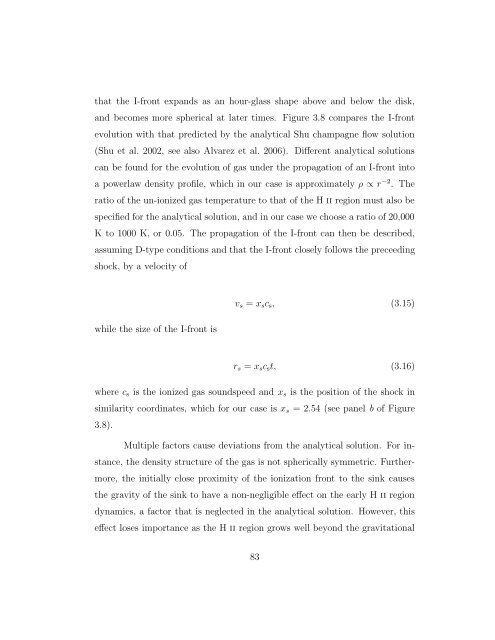Copyright by Athena Ranice Stacy 2011 - The University of Texas at ...
Copyright by Athena Ranice Stacy 2011 - The University of Texas at ...
Copyright by Athena Ranice Stacy 2011 - The University of Texas at ...
You also want an ePaper? Increase the reach of your titles
YUMPU automatically turns print PDFs into web optimized ePapers that Google loves.
th<strong>at</strong> the I-front expands as an hour-glass shape above and below the disk,<br />
and becomes more spherical <strong>at</strong> l<strong>at</strong>er times. Figure 3.8 compares the I-front<br />
evolution with th<strong>at</strong> predicted <strong>by</strong> the analytical Shu champagne flow solution<br />
(Shu et al. 2002, see also Alvarez et al. 2006). Different analytical solutions<br />
can be found for the evolution <strong>of</strong> gas under the propag<strong>at</strong>ion <strong>of</strong> an I-front into<br />
a powerlaw density pr<strong>of</strong>ile, which in our case is approxim<strong>at</strong>ely ρ ∝ r −2 . <strong>The</strong><br />
r<strong>at</strong>io <strong>of</strong> the un-ionized gas temper<strong>at</strong>ure to th<strong>at</strong> <strong>of</strong> the H ii region must also be<br />
specified for the analytical solution, and in our case we choose a r<strong>at</strong>io <strong>of</strong> 20,000<br />
K to 1000 K, or 0.05. <strong>The</strong> propag<strong>at</strong>ion <strong>of</strong> the I-front can then be described,<br />
assuming D-type conditions and th<strong>at</strong> the I-front closely follows the preceeding<br />
shock, <strong>by</strong> a velocity <strong>of</strong><br />
while the size <strong>of</strong> the I-front is<br />
vs = xscs, (3.15)<br />
rs = xscst, (3.16)<br />
where cs is the ionized gas soundspeed and xs is the position <strong>of</strong> the shock in<br />
similarity coordin<strong>at</strong>es, which for our case is xs = 2.54 (see panel b <strong>of</strong> Figure<br />
3.8).<br />
Multiple factors cause devi<strong>at</strong>ions from the analytical solution. For in-<br />
stance, the density structure <strong>of</strong> the gas is not spherically symmetric. Further-<br />
more, the initially close proximity <strong>of</strong> the ioniz<strong>at</strong>ion front to the sink causes<br />
the gravity <strong>of</strong> the sink to have a non-negligible effect on the early H ii region<br />
dynamics, a factor th<strong>at</strong> is neglected in the analytical solution. However, this<br />
effect loses importance as the H ii region grows well beyond the gravit<strong>at</strong>ional<br />
83









